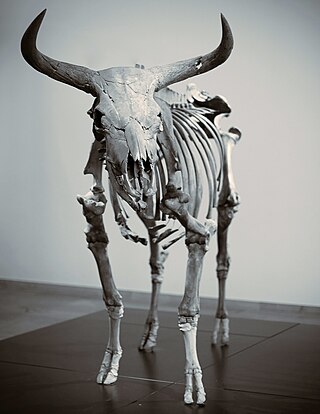
The aurochs is an extinct cattle species, considered to be the wild ancestor of modern domestic cattle. With a shoulder height of up to 180 cm (71 in) in bulls and 155 cm (61 in) in cows, it was one of the largest herbivores in the Holocene; it had massive elongated and broad horns that reached 80 cm (31 in) in length.
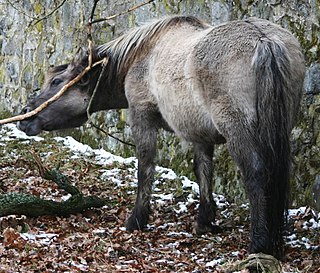
How and when horses became domesticated has been disputed. Although horses appeared in Paleolithic cave art as early as 30,000 BC, these were wild horses and were probably hunted for meat. The clearest evidence of early use of the horse as a means of transport is from chariot burials dated c. 2000 BC. However, an increasing amount of evidence began to support the hypothesis that horses were domesticated in the Eurasian Steppes in approximately 3500 BC. Discoveries in the context of the Botai culture had suggested that Botai settlements in the Akmola Province of Kazakhstan are the location of the earliest domestication of the horse. Warmouth et al. (2012) pointed to horses having been domesticated around 3000 BC in what is now Ukraine and Western Kazakhstan.
The 10th millennium BC spanned the years 10,000 BC to 9001 BC. It marks the beginning of the transition from the Palaeolithic to the Neolithic via the interim Mesolithic and Epipaleolithic periods, which together form the first part of the Holocene epoch that is generally believed to have begun c. 9700 BC and is the current geological epoch. It is impossible to precisely date events that happened around the time of this millennium, and all dates mentioned here are estimates mostly based on geological analysis, anthropological analysis, and radiometric dating.

The water buffalo, also called the domestic water buffalo or Asian water buffalo, is a large bovid originating in the Indian subcontinent and Southeast Asia. Today, it is also found in Italy, the Balkans, Australia, North America, South America and some African countries. Two extant types of water buffalo are recognized, based on morphological and behavioural criteria: the river buffalo of the Indian subcontinent and further west to the Balkans, Egypt and Italy and the swamp buffalo, found from Assam in the west through Southeast Asia to the Yangtze valley of China in the east.

Bovines comprise a diverse group of 10 genera of medium to large-sized ungulates, including cattle, bison, African buffalo, water buffalos, and the four-horned and spiral-horned antelopes. The evolutionary relationship between the members of the group is still debated, and their classification into loose tribes rather than formal subgroups reflects this uncertainty. General characteristics include cloven hooves and usually at least one of the sexes of a species having true horns. The largest extant bovine is the gaur.

Bubalus is a genus of Asiatic bovines that was proposed by Charles Hamilton Smith in 1827. Bubalus and Syncerus form the subtribe Bubalina, the true buffaloes.
Hoabinhian is a lithic techno-complex of archaeological sites associated with assemblages in Southeast Asia from late Pleistocene to Holocene, dated to c. 10,000–2000 BCE. It is attributed to hunter-gatherer societies of the region and their technological variability over time is poorly understood. In 2016 a rockshelter was identified in Yunnan (China), where artifacts belonging to the Hoabinhian technocomplex were recognized. These artifacts date from 41,500 BCE.

The Hemudu culture was a Neolithic culture that flourished just south of the Hangzhou Bay in Jiangnan in modern Yuyao, Zhejiang, China. The culture may be divided into early and late phases, before and after 4000 BC respectively. The site at Hemudu, 22 km northwest of Ningbo, was discovered in 1973. Hemudu sites were also discovered at Tianluoshan in Yuyao city, and on the islands of Zhoushan. Hemudu are said to have differed physically from inhabitants of the Yellow River sites to the north. Some authors propose that the Hemudu Culture was a source of the pre-Austronesian cultures.

A bovid hybrid is the hybrid offspring of members of two different species of the bovid family. There are 143 extant species of bovid, and the widespread domestication of several species has led to an interest in hybridisation for the purpose of encouraging traits useful to humans, and to preserve declining populations. Bovid hybrids may occur naturally through undirected interbreeding, traditional pastoral practices, or may be the result of modern interventions, sometimes bringing together species from different parts of the world.

The Late Pleistocene is an unofficial age in the international geologic timescale in chronostratigraphy, also known as the upper Pleistocene from a stratigraphic perspective. It is intended to be the fourth division of the Pleistocene Epoch within the ongoing Quaternary Period. It is currently defined as the time between c. 129,000 and c. 11,700 years ago. The late Pleistocene equates to the proposed Tarantian Age of the geologic time scale, preceded by the officially ratified Chibanian and succeeded by the officially ratified Greenlandian. The estimated beginning of the Tarantian is the start of the Eemian interglacial period. It is held to end with the termination of the Younger Dryas, some 11,700 years ago when the Holocene Epoch began.
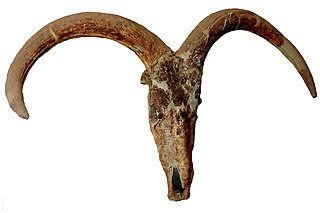
Pelorovis is an extinct genus of African wild cattle which existed during the Pleistocene epoch. The best known species is Pelorovis oldowayensis from Olduvai Gorge in Tanzania, from the Early Pleistocene. The species "Pelorovis" antiquus from the Late Pleistocene-Holocene has since been moved into Syncerus, the same genus as living African buffalo.
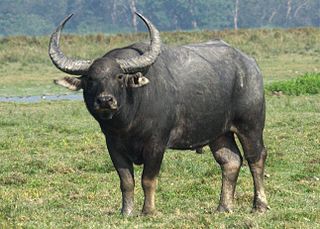
The wild water buffalo, also called Asian buffalo, Asiatic buffalo and wild buffalo, is a large bovine native to the Indian subcontinent and Southeast Asia. It has been listed as Endangered in the IUCN Red List since 1986, as the remaining population totals less than 4,000. A population decline of at least 50% over the last three generations is projected to continue. The global population has been estimated at 3,400 individuals, of which 3,100 (91%) live in India, mostly in Assam. The wild water buffalo is the most likely ancestor of the domestic water buffalo.
Enkapune Ya Muto, also known as Twilight Cave, is a site spanning the late Middle Stone Age to the Late Stone Age on the Mau Escarpment of Kenya. This time span has allowed for further study of the transition from the Middle Stone Age to the Late Stone Age. In particular, the changes in lithic and pottery industries can be tracked over these time periods as well as transitions from a hunter-gatherer lifestyle to a herding lifestyle. Beads made of perforated ostrich egg shells found at the site have been dated to 40,000 years ago. The beads found at the site represent the early human use of personal ornaments. Inferences pertaining to climate and environment changes during the pre-Holocene and Holocene period have been made based from faunal remains based in this site.

The Indian aurochs is an extinct subspecies of aurochs that inhabited West Asia and the Indian subcontinent from the Late Pleistocene to its extinction during the South Asian Stone Age. With no remains younger than 3,800 YBP ever found, the Indian aurochs was the first of the three aurochs subspecies to become extinct, while the North African and Eurasian subspecies survived until the Roman and Modern times, respectively.

Syncerus antiquus is an extinct species of buffalo from the Late Pleistocene and Holocene of Africa. It was one of the largest species in its family, potentially weighing up to 2,000 kilograms (4,400 lb). Due to this fact, it is sometimes known as the African giant buffalo. The time of its extinction is of debate; Syncerus antiquus either became extinct at the end of the Late Pleistocene about 12,000 years ago or during the Holocene, some 4,000 years ago.

Bubalus murrensis, also known as European water buffalo, is an extinct bovine that lived in Europe during the Pleistocene. Its closest living relatives are the wild water buffalo (Bubalus arnee), the tamaraw (Bubalus mindorensis), the lowland anoa (Bubalus depressicornis), the mountain anoa (Bubalus quarlesi) and the domestic water buffalo (Bubalus bubalis).
Bir Kiseiba is a Neolithic archaeological site in Egypt, dating from approximately 11,000-5,000 BP, that lies approximately 250 km west of the Nile in Lower Nubia. Excavated by Fred Wendorf, Romauld Schild, and Angela Close, Bir Kiseiba, along with Nabta Playa, has some of the earliest evidence for food production, permanent settlement, and more diverse technologies as compared to sites from the Late Pleistocene. Wendorf and associates argue that cattle and pottery were here as early as any other place in Africa, although this assertion has been challenged.
Xinglonggou is a Neolithic through Bronze Age archaeological site complex consisting of three separate sites. The sites are located on a loess slope above the left bank of the Mangniu River north of the Qilaotu Mountains in Aohan Banner, Inner Mongolia, China. Xinglonggou is one of the most important sites of the early Neolithic Xinglongwa culture and provides evidence for the development of millet cultivation. The millet assemblage at Xinglonggou consists primarily of broomcorn millet. Xinglonggou is one of the few, early Neolithic sites in China for which systematic flotation has been performed.
Domesticated animals in the Philippines include pigs, chickens, water buffalo, goats, cats, and dogs. Domestication is when a species is selectively bred to produce certain traits that are seen as desirable. Some desirable traits include quicker growth and maturity, increased fertility, adaptability to various conditions, and living in herds. Domesticated animals play an important socioeconomic role in the Philippines, as seen through their widespread use in rituals.
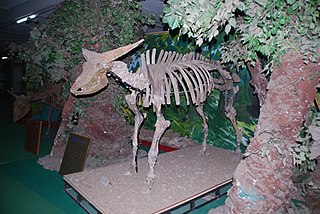
Bubalus wansijocki is an extinct species of water buffalo known from northern China during the Late Pleistocene.














